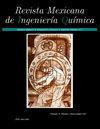Heat and mass transfer heterogeneous model applied for mathematical representation of Aloe vera extracts spray drying
IF 1.3
4区 工程技术
Q4 CHEMISTRY, APPLIED
引用次数: 0
Abstract
Punctual heterogeneous and homogeneous state-space dynamic models for mathematical representation of Aloe vera extracts spray drying were proposed. Punctual heterogeneous model considers 2 partial derivatives di ff erential equations (PDDE) for particles in terms of Fourier’s and Fick’s laws, 2 ordinary di ff erential equations (ODE) for drying air and 3 thermodynamic relations at interface. Homogeneous model considers 4 ODE for air and particles with the same 3 thermodynamic relations at interface. Punctual heterogeneous model was theoretically validated with divergence theorem. On the other way, fresh and concentrated Aloe vera extracts, obtained from plant expression (with 0.43% and 3.93% of total solids), were experimentally spray dried with 180-170 ºC, 100-80 ºC air input-output temperatures. Heterogeneous model solution produced a periodic chaotic dynamic behavior around homogeneous model results which moisture profile within 6.7-7.1 × 10 − 5 m diameter particles. Simulated outlet particle moistures reproduced moderately the experimental ones应用非均质传热模型对芦荟提取物喷雾干燥过程进行数学表征
提出了芦荟提取物喷雾干燥数学表示的时间非均匀和均匀状态空间动力学模型。准时非均匀模型根据傅立叶和菲克定律考虑了2个粒子偏导数微分方程(PDDE)、2个干燥空气的常微分方程(ODE)和3个界面热力学关系。齐次模型考虑了界面处具有相同3个热力学关系的空气和颗粒的4ODE。利用散度定理对准时异构模型进行了理论验证。另一方面,从植物表达中获得的新鲜和浓缩的芦荟提取物(占总固体的0.43%和3.93%)在180-170ºC、100-80ºC的空气输入输出温度下进行实验性喷雾干燥。非均质模型解在直径为6.7-7.1×10-5m的颗粒内的水分分布的均质模型结果周围产生了周期性的混沌动力学行为。模拟出口颗粒湿度适度再现实验结果
本文章由计算机程序翻译,如有差异,请以英文原文为准。
求助全文
约1分钟内获得全文
求助全文
来源期刊
CiteScore
3.60
自引率
33.30%
发文量
50
审稿时长
>12 weeks
期刊介绍:
Revista Mexicana de Ingeniería Química (ISSN 1665-2738) publishes original research articles, with the aim of promoting rapid communication of relevant research in the several disciplines within Chemical Engineering and its interfaces with other engineering disciplines. The contents of the journal are directed to researchers, academics, students and decision makers.
The covered topics are:
Thermodynamics; Catalysis, kinetics and reactors; Simulation and control; Transport phenomena; Safety; Process engineering; Biotechnology; Food engineering; Sustainable development; Environmental engineering; Materials; Applied mathematics and Education.

 求助内容:
求助内容: 应助结果提醒方式:
应助结果提醒方式:


